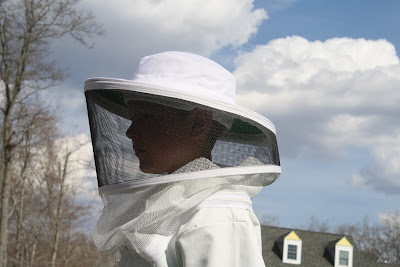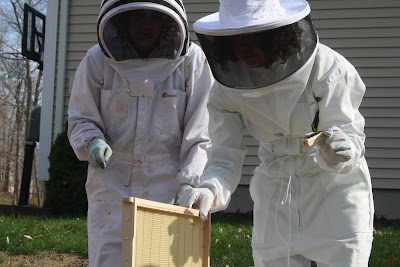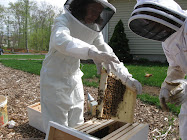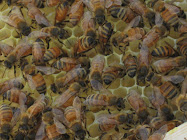Today was a wonderful day! We raced off to church this morning, and after some catching up with friends, came home and got to work outside in the record breaking 87 degree weather in Massachusetts. Lovely. I planted my three different varieties of raspberries: Encore (summer fruiting late), Polana (everbearing), and Killarney (summer fruiting) in the new spot we had created along our side yard. Victor tidied up the area in the back yard: consolidating our leave, grass and yard clipping compost piles, piling up large rocks for later use, and piling up cut wood from a few trees we dropped to make room for future garden area and to provide sunlight for our coming hens. With a little help from me, Victor removed my cold frames from the garden. I have cold weather loving greens ready for consuming -- from Kale to Romaine! Victor also sunk a baby pool into a mulch area along our house that will be 'fed' by a water spout from our gutters -- for our new BEES! Yes, the bees are here and they need a water source. Did you know that bees drank water? Yep. They do.
So, do you want to hear about our new bees? Well, I want to tell you. I hope you'll bear with me as I fill you in on all of the gory details. It was quite a moment for us -- albeit a rather brief one, really. In less than an hour we suited up, got organized and hived our packaged bees.
Here is Benjamin who was eager to get up close and personal with the bees and excitedly suited up in his new Bee Suit. I am so excited to hand this craft down to Benjamin -- do with it what he will. No one can take that knowledge, experience and maybe even a love for it away from him.

My friend Diane has been keeping bees for over 4 years and now has 8 hives at her small farm where she has a substantial vegetable garden and grows pumpkins for sale. She picked up my bees for me yesterday while I was returning home from Florida, and was a dear and oversaw my first install. Like me, when she installed her first hive she hadn't seen a hive in action or anyone 'work their bees'. It was a great comfort to have someone there to guide and reassure me. Thank you. Thank you. Thank you, Diane!

This is how the bees look in their 'packages'. This is a 3 pound box of bees, which I learned recently contains about 10,000 bees. Victor and Benjamin had a hard time believing that. I was too busy concentrating to check for reasonableness. (As you can see from the above expression.)
Before you fiddle with the bees, you spray them with sugar syrup. This keeps them busy grooming themselves while you take off the flat piece of wood covering the top, remove the what was an empty can of sugar syrup, remove the small matchbox sized cage with the queen and a few 'attendants' in it, then dump all the bees in the hive. Someone said that the bees haven't established a home yet to defend, so they aren't organized and as defensive as they would be in their proper hive. Surprisingly, no need to get out the smoker.
One three pound package of bees:

Here is Benjamin looking on.

Here you can see I've pried the slim piece of wood off the top of the package so you can see the can of sugar water. It came out easily with my hive tool -- which according to Diane, is a handy tool for many things!

After I pried out the can, I pry off the queen cage which has been stapled to the package by a piece of strapping. The queen cage needs to be pulled out and set somewhere. For the first package, I set the queen cage in the bottom of the hive. For the second package, I shook the cluster of bees off the cage and placed it on the ground beside the hive.
This is the first package. I'm holding the queen cage. See all of the bees clinging to the cage? Those bees want to be near and care for their queen. Loyal subjects.

Here is the queen cage setting on the bottom of my hive, just temporarily.

Now, when I read about this -- and heard about it in class, I couldn't believe it. You take this box of honey bees and bang it on the ground to get them to fall to the bottom of the box. Then, you flip it over and dump the bees into the hive. Yep, that's what I did.

At this point the bees aren't really worried about you too much, but you can hear them buzzzzzing and some of them do fly around a bit. More so than I was expecting actually. But, Diane wasn't worried, so neither was I. (In the picture below you can see the hole on the bottom of the package and the bees dropping out.)

Since there is just one hole in the middle of a rectangular box there is quite a bit of banging, tipping and dumping going on to get as many bees as possible out of the 'package' and into the hive. You can see Diane holding onto the queen cage we had originally set down in the bottom of the hive (just to have a safe place to put her) while she sprays the bees with more sugar syrup. This way the bees stop flying around in the box and can be dumped out more easily.

OK, now that as many bees as possible are in the hive, it's time to deal with the queen. First I had to shake the bees that were clinging to the queen cage off the cage. When you're not used to it, it's a very counter intuitive thing. It just doesn't seem like a good idea. But, they didn't come at me with all guns blazing or anything -- they just dropped into the hive. Diane had a large nail handy. I used this to pry a small cork out of the queen cage, leaving only a thick candy like mixture plugging the hole and keeping the queen and her 'court' inside the cage. The idea is that you want the queen to be released gradually so that the bees get to know their new queen and accept her. The bees are naturally inclined to eat their way to their queen and within about two days she is free to travel into her hive. To help this process along, a lot of people poke a small hole with the nail into the soft 'candy'. This is what I'm involved in doing in the picture below.

Now I am taking the queen cage and wedging it in between two frames with the screen facing out and the candy side up.

Here I am making sure the queen cage is securely wedged between the frames.

My photographer didn't catch me putting the large pickle jar full of sugar water upside down (with small nail holes punched in the metal top) on top of the inner cover inside the first hive. The top goes on, and the package box is put right by the entrance to the hive so that any stray bees can find their way to be with their friends.

Happy Bee Keeper Sandy, having finished her first hive!

Now, on to hive number two. A few more pictures. Here I am going to pry the can of sugar water out of the package.

Dumping the second package of bees into the second hive. The second time, Diane really stood back and had me do the whole thing. Good teacher.

Sliding the frames back into the hives.

Again, removing the cork plug and putting a hole into the 'candy'.

Here you can see me installing the large pickle jar of sugar water onto the inner cover. Another brood chamber box goes on top of the lower one to enclose the sugar water in the hive. Then, the top goes on and VOILA! Done.

The photographer: Victor, in a veil borrowed by Diane.
Victor has been more excited about the coming hens, but surprised even himself by wanting to see what was going on -- up close and personal. Later in the afternoon when I was looking for Benjamin and Victor, where did I find them? Sitting by the hives, watching the bees.

There they are! Currently the bees are a bit disoriented and confused. They flew around and around their hives . . . not quite knowing what to think of their new digs. In a few days they should be a lot more purposeful.

After the bees are established and oriented in their hives, they wouldn't be too pleased with this up close visitor -- but at this point they were too busy exploring the new home to be concerned with Benjamin. I may have a future bee keeper on my hands. He wanted to keep his suit on so that he could watch the bees up close. After awhile, I told him to give the poor bees a break and back off. When he had one crawling around on him like a pet (after the bee suit was shed), I informed him that it was a drone (male bee), and that drones don't sting. He had a great old time with that fat bee after that! Benjamin thought he was pretty cool.

Ripley (who was napping during the install) getting a tour from Benjamin. The boys stayed outside for a long time just watching the bees, while Victor and I got dinner ready. As evening approached the package boxes were empty and almost all of the bees were snuggled in their new homes. However there were several who were instinctively jumping into their work . . .

the seven short boxwood bushes (previously only inhabited by yellow jackets, bumble bees and wasps) were buzzing with my new honey bees! Tons of them! Isn't that exciting?! They were moving around like mad, so it was tough to get a good shot. Finally, I caught one of them.































3 comments:
Looks & sounds like y'all had a fun & productive day. You should consider doing a home school demo for us sometime. - Dawn, Maria, Becky, myself, etc.- I think it'd be cool to learn all about your hives & chicks, & gardening. :)
I loved your tea you had in FL.- thanks for sharing that with us. So much fun.
Sure I'd be happy to once I have my act together and know what I'm doing. Maybe in September sometime or so. By then my bees will established with comb, brood and honey and my chickens will be just about ready to start laying eggs.
OOOH, you have chickens too? That's so cool. So does my mom, but she's 2.5 hours away so it's not convenient for me to travel there every week.
Great pictures and congratulations on getting your bees hived!
Sarah Murray
Post a Comment